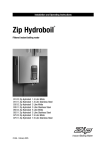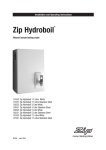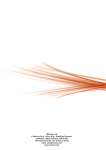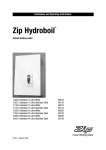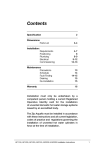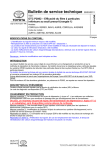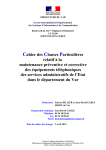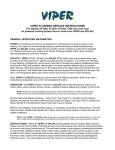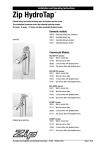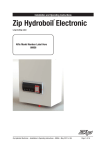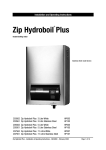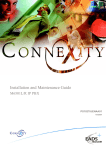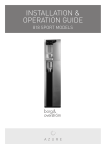Download Zip AquaFlo II AF6250 Instruction manual
Transcript
Installation, Maintenance and User Instructions AquaFlo II Issue 3 – December 2011 Please read these instructions carefully before commencing installation of the AquaFlo unvented water heater Please leave these instructions with the end user INTRODUCTION The corrosion resistant AquaFlo Unvented cylinder is made from Duplex Stainless Steel. It is highly insulated with environmentally friendly foam enclosed in a rust resistant white steel case. It is available in Direct and Indirect versions in a family of 7 sizes from 90 – 300 litres. Twin Coil and Solar Direct units are available in 5 sizes from 150 - 300 litres. To help ensure compliance with the relevant Water and Building Regulations all AquaFlo units are supplied complete with the necessary safety and control devices needed to connect to the cold water mains. In order to ensure high flow-rate performance with minimum pressure drop even in lower pressure areas, pre-adjusted, high quality controls have been selected. INSTALLATION PREREQUISITES This Cylinder should only be installed by a competent installer holding their G3 unvented qualification. The installation of this product is also notifiable under the national building regulations. The electrical installation including earthing and cross bonding must comply with the current IEE regulations and any Local Authority requirements. ONCE COMPLETED THIS INSTRUCTION MANUAL IN ITS ENTIRETY SHOULD BE LEFT WITH THE END USER. STORAGE PRIOR TO INSTALLATION AquaFlo should be stored upright in a dry area and kept in its original packaging until immediately prior to installation. AquaFlo is approved to demonstrate compliance with Water Regulations and Building Regulations G3 & Part L. COLD INLET SET - WHAT ARE THE CONNECTIONS? Internal Check Valve Expansion Relief Valve Pressure Reducing Valve (inc Line Strainer) Discharge To Tundish Cold Supply To Cylinder Cold Mains In Remove Nut For Expansion Vessel Hose Connection Balanced Cold Take Off EQUIPMENT SUPPLIED WITH CYLINDER Control & High Limit Cutout Thermostat (Indirect Models Only) Two Port Zone Valve (Indirect Models Only) Cold Water Inlet Set 15 x 22mm Tundish Temperature & Pressure Relief Valve Expansion Vessel Expansion Vessel Bracket 500mm Expansion Hose Immersion Heater(s) - Dependant on size and configuration Instruction Manual WATER SUPPLY SITING THE UNIT AquaFlo is capable of delivering over 50 litres per minute when connected to a suitable mains supply. The high quality inlet control set with its 3 bar operating pressure has been designed to make the most of what is available, however the performance of any unvented system is only as good as the water supply. AquaFlo can be positioned more or less anywhere in the building but it should be remembered that for every 1 meter that an outlet is above the AquaFlo, the pressure will be reduced by 0.1 bar. If siting outside the heated envelope of the dwelling such as in a garage or outbuilding then frost protection should be provided and exposed pipework should be insulated. In unvented systems both hot and cold services are supplied simultaneously from the mains so the maximum possible on-site water demand must be assessed and the water supply should be tested to ensure it can meet these requirements. If necessary consult the local water supplier regarding the likely pressure and flow rate availability. It is important that site pressure readings are taken under dynamic flow conditions, high pressures under zero flow conditions are not necessarily indicative of satisfactory performance. A minimum of 1.5 bar at 20 l/m flow should be available. Where mains inlet pressures are likely to exceed 12 bar then an additional upstream pressure reducing device should be fitted. AquaFlo must be supported on a flat base capable of supporting the weight of the cylinder when full. The minimum recommended cupboard size is 650mm square. It’s important that consideration is given to access for maintenance of the valves. The immersion heaters are 375mm long and access space should be provided for possible future replacement. A minimum of 22mm supply pipe-work should ideally be provided and existing ½” (15mm) cold mains pipe-work may need to be upgraded. Hard water treatment should be considered in areas where the calcium carbonate content is greater than 200ppm, if required adjust cylinder temperature to below 60 degrees. SCHEMATIC Hot Outlet Expansion Vessel With Wall Bracket Temperature & Pressure Relief Valve Non Return Valve Pump Pressure Reducing Valve Expansion Relief Valve Cold Main * Secondary Return 2 Port Valve Boiler Flow Non Return Valve Tundish Dual Stat Isolating Valve Drain Via Cold Inlet _ Balanc ed Cold Connection Boiler Return * Do not fit shut off valve between Cylinder and Expansion Valve GENERAL INSTALLATION CYLINDER CONNECTIONS All plumbing connections should be made to the Zip AquaFlo and its safety devices using the 15mm or 22mm compression fittings, nuts and olives supplied. CYLINDER RELIEF VALVE CONNECTIONS Safety relief valve connections should not be used for any other purpose and no valve should be fitted between the expansion relief valve and the storage cylinder. COLD MAINS PIPEWORK Run the cold main through the building to the place where the AquaFlo is to be installed. Take care not to run the cold pipe near hot water or heating pipe work so that the heat pick up is minimized. Identify the cold water supply pipe and fit an isolating valve (not supplied). A 22mm BS1010 stopcock can typically be used but a 22mm quarter turn full bore valve would be better as it does not restrict the flow as much. Do not use “screwdriver slot” or similar valves. Make the connection to the cold feed of the cylinder and incorporate a drain valve. Position the inlet control just ABOVE the Temperature & Pressure Relief Valve (TPRV) mounted on the side of the cylinder. This ensures that the cylinder does not have to be drained down in order to service the inlet control set. Ensure that the arrow points in the direction of the water flow. Select a suitable position for the expansion vessel. Mount it to the wall using the bracket provided. Use the hose to connect to the inlet control group. BALANCED COLD CONNECTION If there are to be showers, bidets or monobloc taps in the installation then a balanced cold supply is a requirement. There is a 22mm balanced connection on the inlet control set that must be used for this purpose. HOT WATER PIPEWORK Run the first part of the hot water distribution pipework in 22mm. This can be reduced to 15mm and 10mm as appropriate for the type of tap etc. Your aim should be to reduce the volume of the hot draw off pipework to a practical minimum so that the time taken for the hot water is as quick as possible. Do not use monobloc mixer tap or showers if the balanced cold connection is not provided. This arrangement will back pressurise the unit and result in discharge. Ensure that the top of the vessel is accessible for servicing. PRIMARY COIL CONNECTIONS (Indirect Only) Compression connections are provided for the primary circuit which must be positively pumped. Primary flow and return connections are interchangeable to suit site conditions without affecting reheat times. Sealed or vented primary circuits can be used, to comply with normal installation practice the primary pressure should not exceed 3 bar although the coil in AquaFlo is suitable for up to 7 bar if required. The boiler may be Gas, Electric, Oil etc but must be under effective thermostatic control. AquaFlo is not intended for use with uncontrolled heat sources such as some AGA’s, back boilers, solid fuel stoves etc. The two port zone valve should be installed into the primary flow pipework leading to the coil flow inlet. The direction of flow arrow should be towards the primary flow connection. SECONDARY CIRCULATION Where secondary circulation is required a circulator suitable for potable water should be used in conjunction with a non return valve to prevent backflow. It may be necessary to incorporate an extra expansion vessel into the circuit to accommodate the increased system water volume in larger secondary circulation systems. Where off peak electrical tariffs are being used then secondary circulation should be avoided. A secondary return boss is fitted as standard on 210, 250 & 300L. On smaller sizes tee into the cold feed pipe above the drain. IMMERSION HEATERS As a requirement of Building regulations the AquaFlo immersion heaters are fitted with thermal cut-out in addition to the normal control thermostat. To help ensure correct replacement the immersion heaters have a special 13/4” thread. They are of a low noise Incoloy construction and rated at 3 kW at 240 V. Replacement immersion heaters should be purchased from Zip Heaters otherwise the product warranty may be affected. Under no circumstances should immersion heaters without thermal cut-outs be fitted to the Zip AquaFlo. The O’ring on the head of the immersion heater should be correctly positioned and lubricated before fitting. Screw in until hand-tight then gently tighten as the O’ ring will seal easily. The electrical supply to each immersion heater must be fused at 13A via a double pole isolating switch to BS 3456. The cable must be 2.5mm2 heat resistant (85°C HOFR) sheathed flex complying to BS 6141:1981 Table 8. Do not operate the immersion heater/s until the unit is full of water. If any sterilisation liquid is in the cylinder do not operate the immersion heater/s as this will cause premature failure. The electrical supply must be from a fused supply compliant with local regulations and fitted by a suitably qualified Electrician. ENERGY CUT OUT AND CYLINDER THERMOSTAT (Indirect Only) As a requirement of Building regulations the AquaFlo units are fitted with a thermal cut-out in addition to the normal control thermostat. This unit should be fitted to the dedicated boss on the cylinder and wired to the two port valve controlling the primary flow (see wiring diagram). AQUAFLO UNVENTED INDIRECT Twin Coil Solar Indirect twin coil units can be installed in two separate formats: a) In a solar powered system with a fossil fuel boiler. b) In a system with two independent fossil fuel boilers. With either format it is essential the overall installation meets all current legislation including, in particular, the high limit isolation requirements of Building Regulation G3. This document is designed to assist in achieving this aim. Upper Coil The upper coil is connected to the fossil fuel boiler as per the instructions for the AquaFlo single coil model with the control and high limit thermostat inserted into the middle stat pocket. The wiring requirements are as depicted in this guide. Lower Coil: Solar Installation In a solar powered system the lower coil is connected to the solar heat source. Either primary coil connection may be utilised as the flow or return. The solar cylinder sensor, supplied as part of the solar controls, inserts into the lower stat pocket. It is necessary to mount the solar pump in the return pipework with the two port valve (supplied with the cylinder) installed between the cylinder and the pump. This valve is of the powered open, sprung closed design and is wired through the high limit stat which inserts into the upper stat pocket. Two wiring options for high limit isolation are provided in this guide. The control thermostat is not required in a solar installation. Lower Coil: Two Boiler Installation Where the lower coil is to be used with a fossil fuel boiler, the pipework requirements are as per that of a Stainless Indirect single coil cylinder described earlier in this book. However the electrical requirements mean the control thermostat inserts into the lower tank stat pocket to control the boiler input and the limit stat into the upper tank stat pocket. The two port valve may be installed into either the flow or return pipework. Wiring of the controls are as per the wiring diagram in this guide. DISCHARGE ARRANGEMENT General guidance is provided by the diagram below, extracted from the G3 Building Regulation Guidance. This guidance is available as a free of charge download of the G3 Approved Document from www.planningportal.gov.uk. The discharge from both the Temperature relief and expansion relief valves can be joined together via a 15mm end feed Tee. It is important that any discharge water does not collect in this pipework and can run freely to the tundish. The tundish should be mounted in a vertical and visible position located in the same space as the unvented hot water storage system and be fitted as close as possible and within 500mm of the safety device e.g. the temperature relief valve. The discharge pipe-work from the tundish must be routed in accordance with Part G3 of the Building Regulations. Specification for design installation, testing and maintenance of services supplying water for domestic use within buildings and their curtilages. b) Have a vertical section of pipe at least 300mm long, below the tundish before any elbows or bends in the pipework. c) Be installed with a continuous fall. d) It is preferable for the discharge to be visible at both the tundish and the final point of discharge but where this is not possible or practically difficult there should be clear visibility at one or other of these locations. Examples of acceptable discharge arrangements are: 1. Ideally below the fixed grating and above the water seal in a trapped gulley. 2. Downward discharges at a low level; i.e. up to 100mm above external surfaces such as car parks, hard standings, grassed areas etc. are acceptable providing that where children play or otherwise come into contact with discharges, a wire cage or similar guard is positioned to prevent contact whilst maintaining visibility. 3. Discharges at a high level; e.g. in to metal hopper and metal down pipe with the end of the discharge pipe clearly visible tundish visible or not) or onto a roof capable of withstanding high temperature discharges of water and 3m from any plastic guttering systems that would collect such discharges (tundish available). The discharge pipes and tundish should be installed in a visible location away from any electrical devices, should terminate in a safe place where there is no risk to persons in the vicinity of the discharge, be of metal and: 4. Where a single pipe serves a number of discharges, such as in blocks a) Be at least one pipe size larger than the nominal outlet size of the safety device unless its total equivalent hydraulic resistance exceeds that of a straight pipe 9m long i.e. discharge pipes between 9m and 18m equivalent resistance length should be at least two sizes larger than the nominal outlet size of the safety device, between 18 and 27m at least 3 sizes larger, and so on. Bends must be taken into account in calculating the flow resistance. An alternative approach for sizing discharge pipes would be to follow BS6700 of flats, the number served should be limited to not more than 6 systems so that any installation can be traced reasonably easily. The single common discharge pipe should be at least one pipe size larger than the largest individual discharge pipe to be connected. If unvented hot water storage systems are installed where discharges from safety devices may not be apparent i.e. in dwellings occupied by blind, infirm or disabled people, consideration should be given to the installation of an electronically operated device to warn when discharge takes place. Safety Device (eg: Temperature Relief Valve) Metal Discharge Pipe From Temperature Relief Valve To Tundish Diagram of a typical discharge pipe arrangement (extract from Building Regulation G3) 500mm Max Tundish 300mm Min Note: The discharge will consist of scalding water and steam. Asphalt, roofing felt and non-metallic rainwater goods may be damaged by such discharges. Note: It is not acceptable to discharge straight into a soil pipe. Metal Discharge Pipe From Tundish, With Continuous Fall Discharge Below Fixed Grating Trapped Gulley WIRING DIAGRAM 2 x 2 Port zone valves (Typically Honeywell ‘S’ Plan) W = White G = Grey Bl = Black O = Orange G/Y = Green/Yellow Br = Brown L = Live N = Neutral C = Common SL = Switched Live E = Earth 2 Port (Heating) Br G Bl O 1 Cutout (combined) duostat C E GY 2 2 C E 2 Port (DHW) 2 1 3 Wiring centre 1 2 3 4 5 6 7 8 9 10 1 2 3 4 5 6 7 8 9 10 L N E Br G Bl O GY 1 2 3 3 E L Pump N N 1 2 2 L SL L N E Programmer Room stat Boiler WIRING DIAGRAM 3 Port + 2 Port (Typically Honeywell ‘Y’ Plan) W = White G = Grey Bl = Black O = Orange G/Y = Green/Yellow Br = Brown L = Live N = Neutral C = Common SL = Switched Live E = Earth 3 Port mid position Br G Bl O 2 Cutout (combined) duostat 1 E 2 C G Y C E 2 2 Port (DHW) 1 3 Wiring centre 1 2 3 4 5 6 7 8 9 10 1 2 3 4 5 6 7 8 9 10 L N E Br G Bl O GY 1 2 3 3 E Pump L N N 2 1 2 Room stat L N E Programmer SL L Boiler COMMISSIONING SERVICING FILLING Check all connections for water tightness including any factory made connections such as the immersion heater and the temperature and pressure relief valve. The pressure in the expansion vessel should be checked to ensure it is 3 bar (45PSI). The valve is of the car tyre (Schrader) type. The hot tap furthest away from the AquaFlo should be opened before filling the system to let air out. The system should be flushed before use. The remaining taps should be opened in turn to expel air. DIRECT UNITS The system must be fully filled and flushed before switching on the power to the immersion heaters and allowing the unit to heat up. The immersion heater is supplied preset at 55°C. Turning fully to + sets to approx 65°C. INDIRECT UNITS Ensure the lever on the two port valve is set to the filling position and use the boiler manufacturers commissioning instructions to fill the primary circuit. When full release the lever. Switch the programmer to Domestic Hot water (DHW) and allow the unit to start to heat. Adjust the dial of the dual thermostat to between 55°C and 65°C as required. STORAGE TEMPERATURE A storage temperature of 60-65°C is normal for both direct and indirect AquaFlos. In hard water areas consideration should be given to reducing this to 55-60°C. In many healthcare applications the guidance on Legionella control and safe water delivery temperatures will require storing the water at 60-65°C, distributing at 50-55°C and using thermostatic mixing valves to control the final temperature. For details consult the NHS estates guidance on safe hot water temperatures. SAFETY VALVE CHECKS Any water coming from either the expansion relief valve or the temperature/pressure relief valve during heat up is indicative of a problem which needs to be identified and rectified. The temperature relief and expansion relief valves should be fully opened, one at a time then both together allowing as much water as possible to flow through the tundish. Check that your discharge pipework is free from debris and is carrying the water away without spillage over the tundish and release the valves and check that they reseat properly. GENERAL Servicing should only be carried out by competent installers and any spare parts used must be purchased from Zip Heaters. NEVER bypass any safety devices or operate the unit without them fully operational. DRAINING Isolate from the electrical supply to prevent the immersion heaters burning out. Isolate the unit from the cold mains. Attach a hose to the draining tap ensuring it reaches to a level below the unit. (This will ensure an efficient syphon is set up and the maximum amount of water is drained from the unit). Open the hot tap closest to the unit and open the draining tap. WARNING: WATER DRAINED OFF MAY BE VERY HOT! ANNUAL SERVICING A competent installer should carry out the following checks on an annual basis, ideally at the same time as the annual boiler service. 1) The expansion relief valve on the inlet control set should be eased open allowing water to flow for 5 seconds. The valve should then be closed making sure it re-seats correctly. Repeat this procedure with the pressure/temperature relief valve. Always ensure that the discharge pipework is allowing the water to drain away adequately. If not check for blockages etc. and clear. WARNING: THE WATER DISCHARGED MAY BE VERY HOT! 2) Ensure that any immersion heaters that are fitted are working correctly and that they are controlling the water at a temperature of between 55°C and 65°C. 3) Make sure the pressure in the expansion vessel is charged to 3 bar. Turn off the water supply to the unit and open a hot tap first. The valve on the expansion vessel is a Schrader (standard car tyre) type. Air or CO2 can be used to repressurise the expansion vessel. 4) Remove the head on the inlet control set by unscrewing, and clean the mesh filter within. YOUR WARRANTY MAY BE VOID WITHOUT PROOF OF ANNUAL SERVICING. WARRANTY EXCLUSIONS –THE WARRANTY DOES NOT COVER The AquaFlo stainless steel vessel carries a transferable 25 year warranty against faulty materials or manufacture provided that: The effects of scale build up. Any labour charges associated with replacing the unit or its parts. Any consequential losses caused by the failure or malfunction of the unit. • • • It has been correctly installed by a competent installer as per this document and all the relevant standards, regulations and codes of practice in force at the time. It has not been modified in any way, other than by Zip Heaters (UK) Ltd. No components supplied with the AquaFlo have been removed for unauthorized repair or replacement. • It has not been misused, tampered with or subjected to neglect. • It has only been used for the storage of potable water. • It has not been subjected to frost damage. • The unit has been serviced annually. • The system is fed from a public water supply. • The warranty period commences from the date of purchase subject to registration of the product within 60 days of installation. Please note that invoices for servicing may be requested to prove that the unit has been serviced annually. All the components fitted to/or supplied with the AquaFlo carry a 2 year warranty. . IN THE EVENT OF A PROBLEM CONTACT ZIP HEATERS ON 0845 602 4533 FOR ADVICE USER INSTRUCTIONS Your stainless system is automatic in normal use and requires only annual servicing. You should employ a competent installer to perform the annual servicing. Zip Heaters service department can be contacted on 0845 602 4533 to arrange servicing or repair. IF WATER IS FLOWING FROM THE SAFETY VALVES THROUGH THE TUNDISH THIS INDICATES A FAULT CONDITION AND ACTION IS NEEDED. If this water is hot turn the boiler and/or the immersion heater off. Do not turn off the water until the discharge runs cool. The discharge may also stop. CONTACT ZIP HEATERS ON 0845 602 4533 OR CALL A COMPETENT PLUMBER OUT TO SERVICE THE UNIT. Tell them you have a fault on an unvented cylinder. Zip Heaters stock all the spare parts that may be required ESSENTIAL CYLINDER INFORMATION Maximum water supply pressure .........................................12 Bar Set opening pressure of combined T&P valve...........................7 Bar Operating pressure...................................................................3 Bar Immersed electric element rating................................................... 3kW Maximum primary pressure (indirects only)..........................3 Bar Immersion heater length ....................................................................14” Expansion vessel charge pressure ........................................3 Bar Gross Weight......................................(See cylinder data table below) Expansion valve setting............................................................6 Bar Storage capacity ................................(See cylinder data table below) AquaFlo Direct Storage Capacity Weight Empty Weight Full (kg) 21 Heat up 9kW (mins) Boost re-heat (mins) Heat up 6kW (mins) 76.0 - - - Model (L) Height (mm) x 545 Dia Heat up 3kW (kg) Vol within 10oC of Set Temp. (L) 111 73 Low level Immersion Elements High level Immersion Elements AF3090 90 727 1 0 AF3120 120 915 26 146 102 103.0 - - 58.0 1 1 1.23 AF3150 150 1102 33 183 133 134.0 - - 72.0 1 1 1.41 AF3180 180 1290 38 218 163 164.0 - - 82.0 1 1 1.53 AF3210 210 1478 41 251 194 203.0 - - 96.0 1 1 1.80 AF3250 250 1728 46 296 236 248.0 - - 117.0 1 1 2.15 AF3300 300 2041 55 355 288 323.0 - - 145.0 1 1 2.28 Height (mm) x 545 Dia Weight Empty Weight Full High level Immersion Elements Standing Loss (kg) (kg) Vol Within o 10 C of Set Temp. (L) (mins) Standing Loss (kWh/day) 1.07 AquaFlo Indirect Storage Capacity Model (L) Indirect Heat Exchanger (kW) Recovery Indirect Boost re-heat (mins) (mins) Low level Immersion Elements (kWh/day) AF4090 88 727 23 111 74 16.46 12.0 - 1 0 1.07 AF4120 118 915 30 148 105 16.46 16.0 - 1 0 1.23 AF4150 148 1102 38 186 132 18.55 17.2 - 1 0 1.41 AF4180 178 1290 42 220 160 18.55 20.4 - 1 0 1.53 AF4210 208 1478 45 253 188 18.55 22.0 - 1 0 1.80 AF4250 248 1728 51 299 232 22.00 25.0 117.0 1 1 2.15 AF4300 297 2041 60 357 285 22.00 34.0 145.0 1 1 2.28 AquaFlo Solar Compatible Storage Capacity Model (L) Height Weight Empty (mm) x 545 Dia (kg) Weight Vol within Full 10°C of Set Temp. (kg) (L) Indirect Heat Exchanger (kW) Solar Dedicated Recovery Heat Solar solar Exchanger Capacity (kW) (L) (mins) Boost re-heat Low level Immersion Elements High level Immersion Elements Standing Loss (kWh/day ) (mins) Solar Twin Coil AF5150 147 1102 40 187 132 18.55 16.46 77 25.0* 12.0# 0 1 1.41 AF5180 177 1290 45 222 160 18.55 18.55 95 26.3* 14.8# 0 1 1.53 AF5210 207 1478 48 255 188 22 18.55 101 31.2* 15.5# 0 1 1.80 AF5250 247 1728 53 300 232 22 22.00 107 33.0* 20.0# 0 1 2.15 AF5300 297 2041 63 359 285 22 22.00 121 41.0* 25.0# 0 1 2.28 AF6150 148 1102 38 186 102 - 16.46 80 25.0* 72.0 1 1 1.41 AF6180 178 1290 42 220 123 - 18.55 100 26.3* 82.0 1 1 1.53 AF6210 207 1478 45 253 143 - 18.55 116 31.2* 96.0 1 1 1.80 AF6250 248 1728 51 299 175 - 22.00 137 33.0* 117.0 1 1 2.15 AF6300 298 2041 60 358 210 - 22.00 160 41.0* 145.0 1 1 2.28 Solar Direct * Re-heat times based on BS12897 parameters with an 80°C primary flow at 15 l/min. # Using Indirect heat exchanger. Actual performance when installed will vary considerably dependant on the rate of solar or other renewable input, number of panels etc. NOTE: It is our policy to continually improve products and as such we reserve the right to alter data, specifications and component parts without prior notice. IMPORTANT: No liability is accepted for incorrect use or installation of this product. Zip Heaters (UK) Ltd 14 Bertie Ward Way Dereham Norfolk NR19 1TE Telephone: 0845 602 4533 Telefax: 01362 692448 www.zipheaters.co.uk












